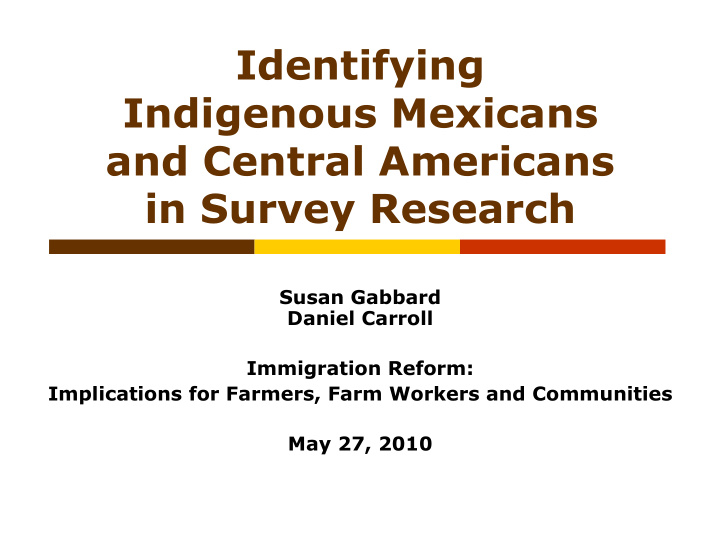



Identifying Indigenous Mexicans and Central Americans in Survey Research Susan Gabbard Daniel Carroll Immigration Reform: Implications for Farmers, Farm Workers and Communities May 27, 2010
Indigenous Mexicans and Central Americans Descendents of Mexico and Central America’s pre-Columbian population, Mayan and other groups Distinct histories and cultures Up to 90 indigenous languages spoken in Mexico Mostly from poor, rural areas Began migrating to the United States in the early 1980s Increasing migration since late 1990s
Challenges of Identifying Important to identify because of unique challenges in labor relations, service delivery, social and civic integration Multi-faceted definition of indigenous Language Geography Race/ethnicity - self-identification Discrimination and self-identification
The National Agricultural Workers Survey Agriculture as a point of entry for poor, often rural, immigrants NAWS is a national probability survey of field workers in crop agriculture US Dept of Labor sponsors and conducted by Aguirre Division of JBS International Establishment survey: Find workers through their employers Complex sampling: multi-stage, stratified, cluster AAPOR4 response rate for establishments is 40%, Grower cooperation 60-70%, List issues reduce RR Worker response rate is >90% Survey mostly done in Spanish
Mexican Sending Regions 50 40 North 30 20 10 West Central 0 South 1994 1997 2000 2003 2006 2009 1992-1994 1995-1997 1998-2000 2001-2003 2004-2006 2007-2009 45% 41% 47% 44% 44% 45% West Central North 45% 43% 32% 32% 29% 27% 10% 16% 21% 23% 27% 27% South
The race question
Primary Language
Indigenous Languages 1999-2007 Achi Jacalteco Quiche Aguateco Kanjobal Tarasco Amuzgo Mam Tepehuano Cakchiquel Maya Tlapaneco Chatino Mazateco Triqui Chinanteco Mixteco Tzeltal Chuj Nahuatl Tzotzil Cora Otomi Visayo Garifuna Popti Zapoteco Ixil Purepecha
Different Ways of Measuring Indigenous Mexicans and Central Americans 18 Race, Child or Primary 16 Language 14 12 Race 10 8 Child Language 6 4 2 Primary language 0 1994 1997 2000 2003 2006 2009 Race, Child or Primary Language 17% 14% Race 3% 5% 9% 11% 13% 11% Child Language 6% 6% Primary language 0% 1% 2% 3% 4% 2% As a percent of Mexican and Central American Farmworkers
Percent of Indigenous Respondents* Identified by: Fifty-five percent of Indigenous respondents were identified only by race, 22% by race and language, 15% by child language, and 8% by primary/child language. *Defined as an affirmative answer to any race or language question
Indigenous Respondents by Migrant-Sending Regions Percent of indigenous West respondents identified by: South Central Total Primary Language 27% 3% 21% Child Language 57% 8% 46% Race 75% 92% 76% Only identified by child language 16% 5% 16%
Summary Indigenous identity is multi-faceted and nuanced Multiple question approach better identifies and allows exploration of components of indigenous identity Need for better geographic measure – municipio of respondent/parent
Contact Susan Gabbard Aguirre Division of JBS International 555 Airport Boulevard sgabbard@jbsinternational.com
Recommend
More recommend